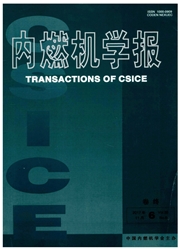

 中文摘要:
中文摘要:
采用不同分子筛催化剂的组合和机内净化的综合控制策略,对汽油机稀燃排放的控制进行了试验研究.试验的催化剂种类包括Cu-In-ZSM5、Ir-ZSM5、Cu-Co-ZSM5、Pd-In-ZSM5、Ni-Cu-ZSM5等.试验考察了空速比对NOx转化效率的影响.综合应用以HC为主要还原气体并可产生CO排放的分子筛催化剂如Ni-Cu-ZSM5、Cu-Co-ZSM5等,和CO、HC协同还原NOx催化效果较好的分子筛催化剂如Ir-ZSM5、Pd-In-ZSM5等,在合适的条件下可以实现70%以上的NOx转化率.催化后NOx浓度降至150×10^-6以下.同时与当量空燃比燃烧时相比仍可节油8%~10%.多种催化剂的综合使用,使得催化活性随温度变化的规律变得复杂.
 英文摘要:
英文摘要:
Experimental study was performed to decrease the emissions of lean burn gasoline engine. The integrated control strategy by using the different zeolite catalysts was proposed and engine modification was made. The catalysts used in the tests include Cu-In-ZSM5, Ir-ZSM5, Cu-Co-ZSM5, Pd-In-ZSM5 and Ni- Cu-ZSMS. The effect of air velocity ratio on NOx conversion efficiency was evaluated. Combination of the zeolite catalysts like Ni-Cu-ZSM5, Cu-Co-ZSM5, which can realize HC-SCR (Selective Catalytic Reduction) reaction and produce CO emission, with the catalysts like Ir-ZSM5 and Pd-In-ZSM5, which can realize CO-SCR and HC-SCR reaction, the conversion efficiency of NOx reaches 70% at an appropriate condition. NOx concentration can be reduced less than 150 × 10^-6. Meanwhile, the lean burn engine gains 8 to 10 percent in fuel economy improvement comparing with that the stoichiometric mixture conditions. The behavior of catalyst activity versus temperature variation becomes complex when using different zeolite catalysts.
 同期刊论文项目
同期刊论文项目
 同项目期刊论文
同项目期刊论文
 期刊信息
期刊信息
